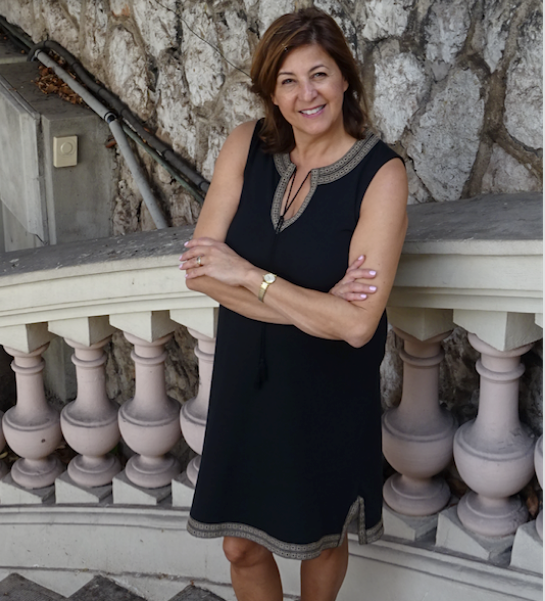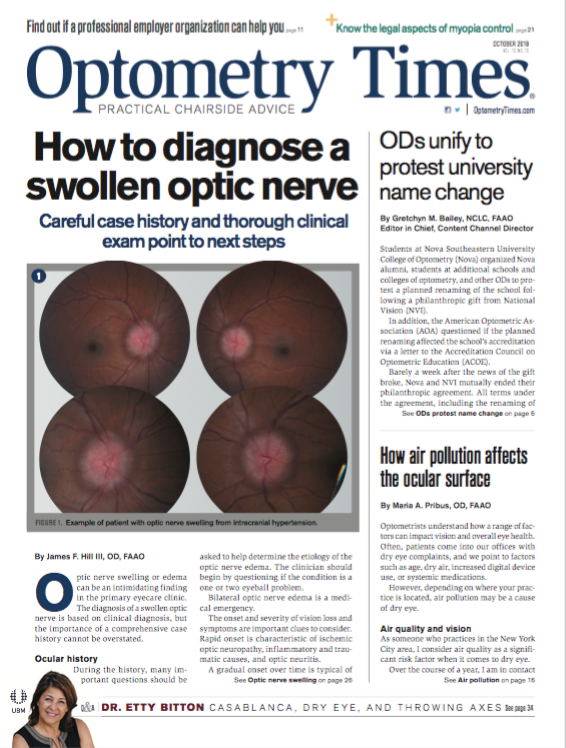Q&A: Casablanca, dry eye, and throwing axes

Meet Etty Bitton, OD, MSc, FAAO, FBCLA, associate professor, director of externships, and director of the Dry Eye Clinic at the School of Optometry, University of Montréal, Canada.
Where did you grow up?
Most of my life I’ve grown up in Montréal. I am one of six children. My dad’s an architect, and my mom did quite few things over the years, most of it was having her family. She’s been a teacher and a part-time nurse, and she kept re-inventing herself over the years. I admire that.
Why contact lenses and why dry eye?
I did optometry practice for several years, then joined the university faculty. My clinical masters was in the tear film. That made me realize how many people suffer from dry eye or dry eye-related problems. I think our environment has changed, our visual needs are different now. With the use of digital devices, we need better vision. People are living longer active lives. I love it. I don't get bored of it. It drives my passion.
Why academia instead of private practice or industry?
I was in practice for about 10 years and started to slow that down as I got an opportunity in academics. You typically come in as a supervisor one day a week, somebody talks to you about a project or about a course and you say, “I’ll do that course.” You get sucked in to this academic black hole. [Laughs] I don’t regret being in academics. It’s offered me opportunities that I otherwise wouldn’t have had in clinical practice-to meet colleagues from around the world and to go to conferences to share my knowledge or get knowledge at a teaching level.
What’s something your colleagues don’t know about you?
I was born in Casablanca, Morocco. I left when I was 5 years old. My parents were born in Casablanca, things became unstable, and they wanted opportunities. My dad was able to transfer with his company, so we came to Montréal. My parents both spoke French, and it was an easier transition for them. They moved to Montréal when they were about 35 years old. It was a hard decision, and they made me realize how much they sacrificed later in life. I wouldn’t have had the opportunities back there that I’ve had in a Canadian environment.
How did the University of Montréal dedicated dry eye clinic come to be?
The Dry Eye Workshop (DEWS) in 2007 showed us a systematic approach to dry eye. We weren’t doing that; we all thought we were doing the right thing. We toyed around with the idea for awhile until we said, “We have a contact lens clinic, we have a binocular vision clinic, we have a low vision clinic. Why don’t we have a dedicated dry eye clinic?” Patients are thrilled because they’re saying, “Someone is actually taking me seriously.” We started with half a day a week and eventually we had a three-month back up. Now we’re at two days a week, and there’s probably room for more.
Why is it important for ODs to have a strategy for patient’s a dry eye work up?
We are slowly unraveling the many facets of dry eye. It is a disease that affects many tissues, so that complexity has made it difficult to be simplistic in our approach. You need to show the evidence and how to educate the patient. One example is the warm compress. Everyone has a facecloth at home. But we’ve shown now that it is inefficient at providing the heat that is necessary to help.That proof has to take time to trickle down through the evidence to get the word out to the optometrist so they understand it and tell the patient. Another is lid hygiene. Everyone says just use baby shampoo. Now it’s potentially harmful to the tear film. We shouldn’t be advocating that, but we say it without questioning. Now we have to be more evidence-based. Do I have data to back this up, and has this data changed over the years? It’s my job as a clinician to be at the forefront of that change. I need to educate myself to make sure I know the latest thing that I’m recommending to my patients.
How did you get interested in demodex mites?
I went to a conference at the American Academy of Optometry, and they threw up a lot pictures of demodex. I sat there going, “Wow! I don’t think I’ve ever seen this!” Yet, when they showed picture of lids, I said, “But I’ve seen this.” We don’t typically pull out a lash and look at it under a microscope. What made the difference for me is if you have patients over 70, the likelihood of having demodex as a cause of blepharitis is nearly 100 percent. I may have missed this for a long time-I felt guilty as a practitioner but also curious. Monday morning, I got a microscope and started pulling lashes. To my astonishment, I could not believe how many people demodex. Then demodex started to be a buzz at conferences. I have many students now doing projects on demodex. I think it’s kind of cool. I like to see the little bugs under the microscope move. I think it makes patients be 100 percent compliant when they see them. [Laughs.]
What’s something you would change about optometry?
Politically, optometry has come a long way, but it hasn’t been taken as seriously as another health profession. I think the individual patient sees our value, but as you move up the healthcare scale, we have work to do. We need to be better represented at the higher levels of health care.
What’s your guilty pleasure food?
I love French tarts, and my favorite is a strawberry French tart. My guilty pleasure is to go to a really nice patisserie and get a nice strawberry French tart. There is one just up the street.
Do you have any regrets?
No. If I had to choose a regret-and it’s not a regret but a challenge of this job, is the family-work balance. If you’re at a conference and you’re missing your kid’s show, whatever it is, you feel guilty it. On the other hand, when you’re at your kid’s show, you’re like, “God, I’ve got to get this thing in by tomorrow morning,” so you feel guilty-this continual teeter-tottering guilt. [Laughs]
What’s the craziest thing you ever did?
Last year, we had a group of women colleagues come to Montréal, and I looked for something fun-crazy to do. We went axe-throwing. [Laughs] I thought it would be absolutely hysterical with this group of women. We had an absolute riot. They tell you a bit of history of axe throwing and the mechanics of how an axe spins, and you get a chance to throw axes. We were all academic ODs or in industry, and we needed to relieve a lot of pressure. You would love the name because it is called Rage. [Laughs]

Newsletter
Want more insights like this? Subscribe to Optometry Times and get clinical pearls and practice tips delivered straight to your inbox.